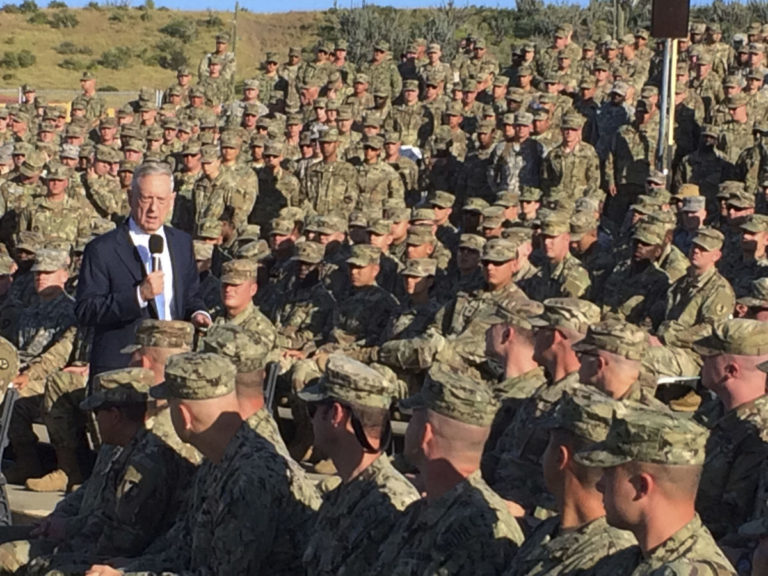Defense Secretary Jim Mattis chose an unusual site Thursday to begin a pre-holiday tour of military bases, urging troops on this Navy base to set a good example for politically divided Americans and be always ready for war. He gave no hint about the future of Guantanamo Bay as a prison for terror suspects, and did not visit the detention center, which President Barack Obama tried unsuccessfully to close.
Mattis, the first defense secretary to visit the base since Donald H. Rumsfeld in January 2002, shortly after the first prisoners arrived from Afghanistan, said the main goal of his trip was to offer holiday cheer and let the troops know their work is appreciated. He also made a point of defending the way prisoners have been treated at Guantanamo Bay, which has been called an infamous torture center. “I am confident that we’re doing the right thing here,” he said.
He recalled a conversation early this year with a woman, whom he did not name, who told him Guantanamo Bay was “a blot on our nation,” but when invited to accompany him to the detention center for an unannounced visit, she declined. “That shut her up. She didn’t have anything more to say to me,” he said.
Mattis wanted to buck up the troops at Guantanamo and at Naval Station Mayport, near Jacksonville, Florida, where he visited later Thursday. He was accompanied by an Associated Press reporter and planned on Friday to visit Marines at Camp Lejeune, North Carolina, and soldiers at Fort Bragg, North Carolina.
The troops he saw on Thursday seemed most curious about what some are calling the road to war with North Korea, whose nuclear weapons the Trump administration says pose a grave and intolerable threat.
In a series of talks with troops throughout the day, North Korea came up time and again, mostly from the troops. Each time, Mattis said the focus is on finding a diplomatic solution with the help of China, Russia and others.
But he also made no bones about what might happen if the diplomats fail.
“If we have to do it (militarily), we expect to make it the worst day in North Korea’s life,” he said, adding that if war comes, “every submarine he’s got is to be sunk and every ship he’s got is to be sunk,” he said, referring to Kim Jong Un, the young North Korean leader who has threatened to use his nuclear weapons on the U.S.
Mattis said he gets asked about the North Korea problem everywhere he travels. He said he plans on attending a meeting in Vancouver, Canada, next month of foreign ministers of the countries that jointly fought the 1950-53 Korean War. He said he will brief them on the situation in Korea. “When I leave, we leave this in the diplomats’ hands.”
Perhaps tellingly, Mattis mentioned that he is now re-reading T.R. Fehrenbach’s “This Kind of War,” a classic history of the war published in 1963 and originally subtitled “A Study in Unpreparedness.” The first U.S. Army units thrust onto the peninsula to stop the North’s invading force were overrun, and U.S. military leaders ever since have considered Fehrenbach’s book a teaching tool.
Mattis was asked if the U.S. has worked out planning for a post-war Korean Peninsula, including the issue of reunifying the North and South. He answered indirectly by saying, “We’re probably not where we need to be” in such discussions with Russia, China and others.
Speaking to a few dozen Marines at a rifle range, Mattis described North Korea as a “not yet imminent but a direct threat to the United States.”
At another point, at an outdoor movie theater where troops and civilian staff had gathered, Mattis said that during the Cold War, U.S. leaders had been confident that Russia and China did not want to start a nuclear war.
“That may be an assumption we cannot make” with Kim, he said.
He urged the sailors at Mayport, as well as the troops at Guantanamo Bay, to be ready in case war comes.
“You must be ready,” he said, “and you must demonstrate you’re ready” in order to improve the chances of a peaceful resolution.
“I need you to be at the top of your game,” he told an assembly of several hundred troops at Guantanamo Bay, citing their roles both as a fighting force and as a positive example for a divided civilian society.
Although Mattis did not visit the detention center at Guantanamo, he did stress the importance of keeping the Navy base as a U.S. toehold in southeastern Cuba. He said it will not be abandoned, regardless of the future of the prison.
“We need this base badly,” he said, as a strategic spot to conduct humanitarian relief and other naval operations, as it had before the Sept. 11, 2001, attacks.
President Donald Trump hasn’t released any Guantanamo prisoners or added any to the list of men who have been officially cleared to go home or to a third country for resettlement.
Forty-one prisoners remain in detention. Ten have been charged by a military commission. Five have been cleared to leave, but their status is in doubt under the current administration.
That leaves 26 in indefinite confinement. Some eventually could be cleared for release, too, or prosecuted.
(AP)











